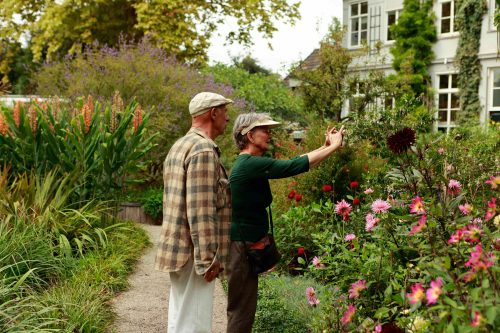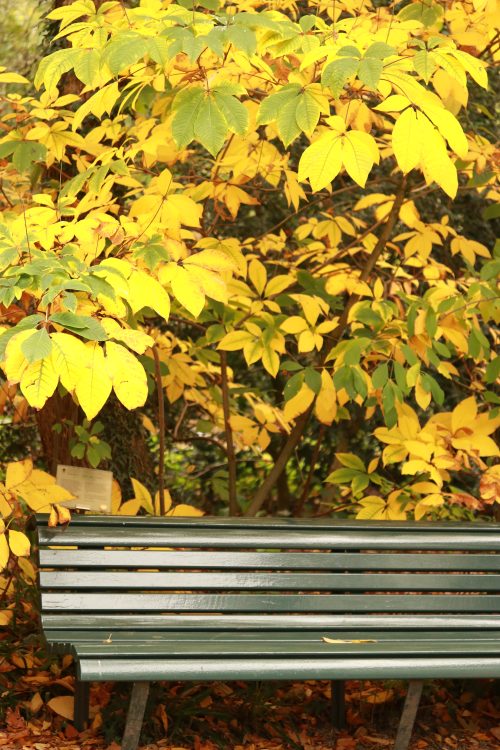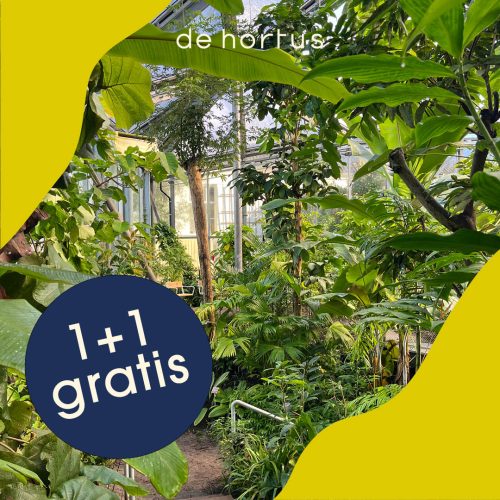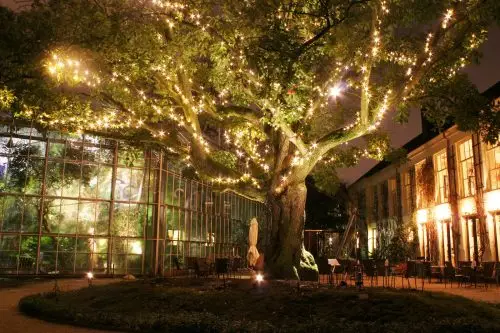🤩𝘈𝘭𝘰𝘦 𝘧𝘭𝘦𝘹𝘪𝘭𝘪𝘧𝘰𝘭𝘪𝘢 is slowly starting to flower in our desert greenhouse.
🌵It`s a critically endangered species, which can only be found in a small area in Tanzania, in the Usambara Mountains.
-
🤩𝘈𝘭𝘰𝘦 𝘧𝘭𝘦𝘹𝘪𝘭𝘪𝘧𝘰𝘭𝘪𝘢 begint langzaam te bloeien in onze woestijnkas.
🌵Het is een ernstig bedreigde soort, die alleen voorkomt in een klein gebied in Tanzania, in het Usambara-gebergte.

🫡🎁𝗔𝗺𝘀𝘁𝗲𝗿𝗱𝗮𝗺𝗺𝗲𝗿𝘀 𝗼𝗽𝗴𝗲𝗹𝗲𝘁! De Hortus heeft een cadeautje voor jullie deze decembermaand.
👯Van 1 t/m 31 december is er de speciale 1+1 ticket, waarmee je met z’n tweeën de Hortus kunt bezoeken voor slechts €13,50 (dat is twee voor de prijs van één).
🤗Afgelopen zomer openden wij onze nieuwe Klimatenkas met een speciaal programma voor Amsterdammers. En we sluiten dit jaar af met nog een allerlaatste cadeautje: een 1+1 ticket voor Amsterdammers.
🏝️De kas is in de winter natuurlijk de uitgelezen plek om lekker op te warmen. Boek een korte reis naar de tropen of het Zuid-Afrikaanse landschap. Koop je ticket via de 𝗹𝗶𝗻𝗸 𝗶𝗻 𝗯𝗶𝗼 (en lees nog even de voorwaarden). Tot snel!
👀Deze actie geldt niet voor de Winteravonden - dit is een aparte actie. (Je kunt natuurlijk wel gezellig blijven hangen tot de Winteravond van start gaat!).

😊This is the beautiful 𝗱𝘂𝗶𝗻𝗲𝗿𝗶𝗲𝘁 (𝘛𝘩𝘢𝘮𝘯𝘰𝘤𝘩𝘰𝘳𝘵𝘶𝘴 𝘴𝘱𝘪𝘤𝘪𝘨𝘦𝘳𝘶𝘴).
🌾With its elegant, reed-like stems and fine texture, this plant sways beautifully in the wind, adding movement and structure to Western Cape fynbos landscapes. Unlike true grasses, Thamnochortus belongs to the Restionaceae family - a fascinating group of plants adapted to nutrient-poor, sandy soils and fire-prone environments. 🔥
You can find it in our Cape greenhouse!
-
😊Dit is het prachtige 𝗱𝘂𝗶𝗻𝗲𝗿𝗶𝗲𝘁 (𝘛𝘩𝘢𝘮𝘯𝘰𝘤𝘩𝘰𝘳𝘵𝘶𝘴 𝘴𝘱𝘪𝘤𝘪𝘨𝘦𝘳𝘶𝘴).
🌾Met zijn elegante, rietachtige stengels en fijne textuur wiegt deze plant prachtig in de wind en voegt hij beweging en structuur toe aan de fynboslandschappen van de West-Kaap. In tegenstelling tot echte grassen behoort Thamnochortus tot de familie Restionaceae, een fascinerende groep planten die zich heeft aangepast aan voedselarme, zandige bodems en brandgevoelige omgevingen. 🔥
Je vindt hem in onze Kaapse kas!

😴Slapen planten `s nachts (zoals deze duttende 𝘖𝘹𝘢𝘭𝘪𝘴 𝘰𝘣𝘵𝘶𝘴𝘢)?
Kunnen planten het eigenlijk koud hebben? En wist je dat een kerstboom helemaal geen dennenboom is?🎄
🌜️Deze en andere onderwerpen worden behandeld tijdens de speciale Winteravond-rondleidingen: 𝗣𝗹𝗮𝗻𝘁𝗲𝗻𝗹𝗲𝘃𝗲𝗻 𝗶𝗻 𝗵𝗲𝘁 𝗱𝗼𝗻𝗸𝗲𝗿.
🍷Ervaren rondleiders nemen je mee op een avondlijke plantenreis door de verlichte tuin en kassen. Na afloop kun je genieten van een warme choco of glühwein op ons terras.
👉🏽Tickets via de 𝗹𝗶𝗻𝗸 𝗶𝗻 𝗯𝗶𝗼!
-
😴Do plants sleep at night (like this 𝘖𝘹𝘢𝘭𝘪𝘴 𝘰𝘣𝘵𝘶𝘴𝘢 taking a nap)? Can plants actually feel cold?
🌜️These and other topics will be covered during our special Winter Evening tours: 𝗣𝗹𝗮𝗻𝘁 𝗹𝗶𝗳𝗲 𝗶𝗻 𝘁𝗵𝗲 𝗱𝗮𝗿𝗸.
🍷Experienced guides will take you on an evening tour through the illuminated garden and greenhouses. Afterwards, you can enjoy a hot chocolate or mulled wine on our terrace.
👉🏽Tickets via the 𝗹𝗶𝗻𝗸 𝗶𝗻 𝗯𝗶𝗼!
(Please note: these tours are in Dutch only).

🎺With its large, pendulous blooms and sweet fragrance, 𝘉𝘳𝘶𝘨𝘮𝘢𝘯𝘴𝘪𝘢 𝘢𝘶𝘳𝘦𝘢 or 𝗮𝗻𝗴𝗲𝗹`𝘀 𝘁𝗿𝘂𝗺𝗽𝗲𝘁 is a showstopper of the garden.
🗻Native to the Andean regions of South America, this tropical shrub can produce spectacular trumpet-shaped flowers up to 25 cm long! While breathtakingly beautiful, every part of this plant is highly toxic.
📍Come see its golden blossoms in person in our Palm House.
-
🎺 Met zijn grote, hangende bloemen en zoete geur is 𝘉𝘳𝘶𝘨𝘮𝘢𝘯𝘴𝘪𝘢 𝘢𝘶𝘳𝘦𝘢 of 𝗲𝗻𝗴𝗲𝗹𝗲𝗻𝘁𝗿𝗼𝗺𝗽𝗲𝘁 een echte blikvanger in de tuin.
🗻Deze tropische struik komt oorspronkelijk uit de Andes in Zuid-Amerika en kan spectaculaire trompetvormige bloemen produceren die wel 25 cm lang kunnen worden! Hoewel de plant adembenemend mooi is, is elk deel ervan zeer giftig.
📍Kom de gouden bloemen bekijken in onze Palmenkas.

🌴Enter our magical Palm House: filled with centuries old cycads, palms and other magnificent plant species.
💚🧣Many of these green inhabitants were standing in the outside garden all summer long - but with the temperatures getting colder it`s time they go back into their warm winter shelter.
-
🌴Betreed onze magische Palmenkas: gevuld met eeuwenoude cycadeeën, palmen en andere prachtige plantensoorten.
💚🧣Veel van deze groene bewoners stonden de hele zomer lang in de buitentuin, maar nu de temperaturen dalen is het tijd dat ze terugkeren naar hun warme winterverblijf.

🍇These are the berries of the 𝗱𝗲𝗮𝗱𝗹𝘆 𝗻𝗶𝗴𝗵𝘁𝘀𝗵𝗮𝗱𝗲 (𝘈𝘵𝘳𝘰𝘱𝘢 𝘣𝘦𝘭𝘭𝘢𝘥𝘰𝘯𝘯𝘢) - a plant as enchanting as it is perilous.
Once used by Renaissance women to dilate their pupils for a `beautiful` gaze (hence belladonna, or `beautiful lady`), its shiny black berries hide a toxic secret. Just a few can cause hallucinations, delirium… or worse 😵💫. So, look but don`t touch!
-
🍇Dit zijn de bessen van de 𝘄𝗼𝗹𝗳𝘀𝗸𝗲𝗿𝘀 (𝘈𝘵𝘳𝘰𝘱𝘢 𝘣𝘦𝘭𝘭𝘢𝘥𝘰𝘯𝘯𝘢) - een plant die even betoverend als gevaarlijk is.
Vroeger werd deze plant door vrouwen in de Renaissance gebruikt om hun pupillen te verwijden voor een ‘mooie’ open blik (vandaar belladonna, of ‘mooie dame’), maar de glanzende zwarte bessen verbergen een giftig geheim. Slechts een paar bessen kunnen hallucinaties, delirium... of erger veroorzaken 😵💫. Dus, kijken maar niet aanraken!

🧡This adorable orange flower belongs to 𝗕𝗼𝗸𝗯𝗮𝗮𝗶 𝗯𝘂𝘁𝘁𝗼𝗻𝘀 (𝘊𝘰𝘵𝘶𝘭𝘢 𝘥𝘶𝘤𝘬𝘪𝘵𝘵𝘪𝘢𝘦).
🏝️It`s a threatened species and only grows in a few locations, on sandy coastal slopes along the West Coast of South Africa.
👀Look for its orange buttons in our Cape greenhouse.
-
🧡Deze schattige oranje bloem hoort bij de 𝗕𝗼𝗸𝗯𝗮𝗮𝗶 𝗯𝘂𝘁𝘁𝗼𝗻𝘀 (𝘊𝘰𝘵𝘶𝘭𝘢 𝘥𝘶𝘤𝘬𝘪𝘵𝘵𝘪𝘢𝘦).
🏝️Het is een bedreigde soort die slechts op enkele locaties groeit; op zanderige kusthellingen langs de westkust van Zuid-Afrika.
👀Zoek naar z`n oranje `knoopjes` in onze Kaapse kas.






